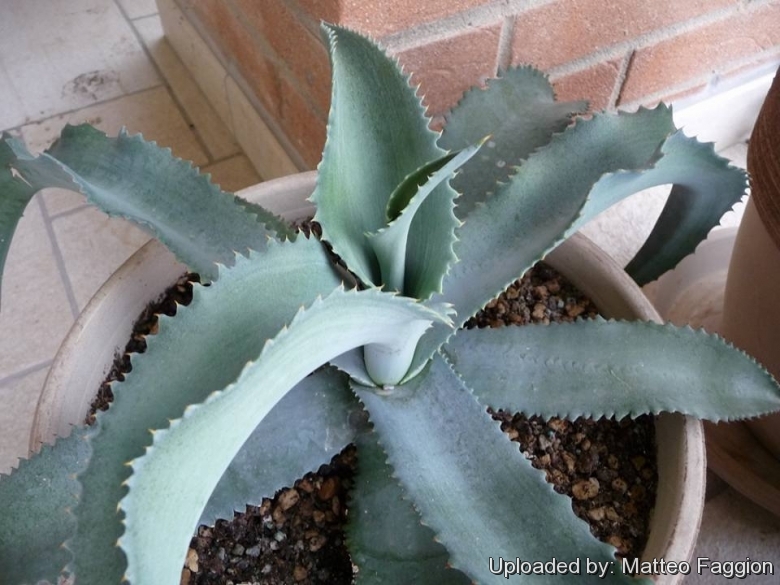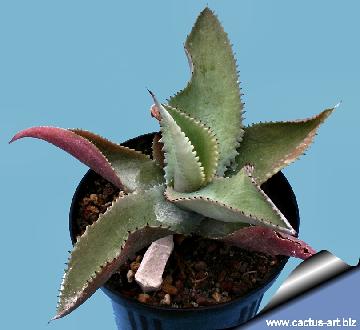




Your support is critical to our success.

This is a large forest dweller species that forms a loose rosette of soft, fleshy, pale green leaves. This is not a desert plant and appreciates a warm environments in filtered light and plenty of water during the active growing phase.
Origin and Habitat: Agave gypsophilaSN|505]]SN|505]] grows in the Mexican states of Jalisco (Mpio. de Pihuamo), Colima (Mpio. de Colima), Michoacan and Guerrero (Mpios. de Chilpancingo, Acahuizotla, Mochitlán)
Altitude range: 370-930(-960) metres above sea level.
Habitat and ecology: This is an understorey species that occurs in rocky ravines in tropical deciduous lowland thorn forest, on calcareous or gypseous rocks. The species is locally abundant but its overall distribution is narrow. It is sensitive to frost, low temperatures can cause severe injury or death of individuals. Their habitats have been destroyed and fragmented by human intervention, mainly in the Guerrero state.
Synonyms:
- Agave gypsophila Gentry
Agave gypsophila Gentry
Agaves Cont. N. Amer. 510 (1982).
Cultivars (2):
ENGLISH: Gypsum Century Plant
LITHUANIAN (Lietuvių): Gipsinė agava
SPANISH (Español): Maguey de ixtli, quiote, calegual, Maguey del yeso, Maguey
Description: Agave gypsophilaSN|505]]SN|505]], (Gypsum Century Plant), is a small sprawling agave, that forms a single loose rosette of soft, fleshy, leaves that can reach a diameter of up to 2 m. The leaves are easily distinguished, linear, very brittle, grey with small narrowly-spaced teeth along the wavy margins. Young emerging pale gray-green leaves clasp together in a tube-like manner before curving out and down and turning more wavy and greyer in colour, creating an overall fountain-like effect. When the infrequent flowering occurs, the yellow flowers are born on 2-3 m tall panicle.
Rosettes: Openly spreading, solitary (non-surculose), 0.8–1 m tall with few leaves (10–11 or up to 30 in mature rosettes).
Derivation of specific name: The specific epithet refers to the rocky calcareous
habitat where it grows.
Leaves. 45-100(-110) cm long, 7-12 cm wide, linear-lanceolate, generally arching, weak, brittle, smooth, not evidently cross-zoned, and with few fibres, thick, slightly narrowed near the base, deeply convex be-low, flat above, asperous, glaucous-grey, margins closely dentate with small prominences. Marginal teeth weak, 1-2 mm, with small intermittent teeth. Terminal spine conical, very small, 9–11 mm long, dark brown, not decurrent.
Inflorescences: 2-3 m tall, `paniculate', straight to curved, with relatively few, widely spreading, few-flowered, part-inflorescences, in the upper half of the slender scape, in cultivation bulbilliferous.
Flowers: Yellow to orange 31–34 mm long. Pedicel lender small-bracteolate. Ovary spindle-shaped, 18-20 mm long, neck grooved. Tepals yellow. Tube broadly funnel-shaped, 4 -5 mm long. Lobes about equal, 10-11 mm long. Filaments 20-25 mm long. Anthers 11-12 mm long, yellow.
Blooming season: The flowering period extends from from February to June; fruiting from March to July.
Subspecies, varieties, forms and cultivars of plants belonging to the Agave gypsophila group
 Agave gypsophila Gentry: It is a blue grey coloured small Agave with attractive wavy foliage.
Agave gypsophila Gentry: It is a blue grey coloured small Agave with attractive wavy foliage. Agave gypsophila cv. Ivory Curls: it is a user-friendly agave with wavy turquoise leaves edged in ivory-cream.
Agave gypsophila cv. Ivory Curls: it is a user-friendly agave with wavy turquoise leaves edged in ivory-cream. Agave gypsophila cv. Lemon and Lime: has subtle shade of lime green to yellow variegation.
Agave gypsophila cv. Lemon and Lime: has subtle shade of lime green to yellow variegation.
Bibliography: Major references and further lectures
1) Howard Scott Gentry “Agaves of Continental North America” University of Arizona Press, 01 February 2004
2) Urs Eggli “Illustrated Handbook of Succulent Plants: Monocotyledons” Springer Science & Business Media, 06 December 2012
3) San Marcos Growers contributors Agave gypsophila - Gypsum Century Plant San Marcos Growers <http://www.smgrowers.com/products/plants/plantdisplay.asp?plant_id=2858>. Web. 17 June 2016.
4) Bernd Ullrich “Agave gypsophila” In: Kakteen und andere Sukkulenten. Volume 42, number 3, Karteikarte 18, 1991.
5) J. Antonio Vázquez-García, Miguel Á. Muñiz-Castro, Eduardo Sahagún-Godínez,
Miguel de J. Cházaro-Basáñez, Ernesto De Castro-Arce, Gregorio Nieves-Hernández,
and Jesús Padilla-Lepe1 “Four New Species of Agave (Agavaceae) of the Marmoratae Group” Systematic Botany (2013), 38(2): pp. 1–12
6) Illsley-Granich, C., G. Rivera, A. Tlacotempa, P. Morales, J. García, T. Gómez, J. M. Martínez, J. Marcial, F. Castro, M. Calzada, S. Mancilla, P. García, L. Casarrubias, F. Hernández, and J. Flores. 2004. “Manual de manejo campesino de magueyes mezcaleros silvestres. Primera edición.” México, D. F. CONABIO, Grupo de Estudios Ambientales, AC, Rainforest Alliance.
7) Pureco-Ornelas, Y., P. G. Miranda-Pacheco, and J. A. Zavala-Hurtado. 2001. “Casas en el desierto: babosos y calehuales.” Contactos 41: 45–50.
8) García Mendoza, A. J. 2003. “Ficha técnica de Agave gypsophila. Revisión de las Agavaceae (sensu stricto), Crassulaceae y Liliaceae incluidas en el PROY-NOM-059-ECOL-2000.” Jardín Botánico, Instituto de Biología, Universidad Nacional Autónoma de México. Bases de datos SNIB-CONABIO. Proyecto No. W020. México, D.F.

Agave gypsophila Photo by: Cactus Art

Agave gypsophila Photo by: Valentino Vallicelli
Cultivation and Propagation: Agave gypsophilaSN|505]]SN|505]] is a stunning specimen plant for containers or a well drained spot in the garden. It tend to be slow grower, but worth the effort. Protect from frost - this Agave is noted to be severely damaged at temperatures below – 3°C. Because of its frost sensitivity and preference to a shady location, grow this plant in a light shade or in morning sun. Agave gypsophilaSN|505]]SN|505]] is a curious and attractive plant that is very different from other Agave. Makes a good container plant.
Soil: Grow it in porous soil with adequate drainage.
Exposure: It do well in filtered sun or a shaded area.
Water requirements: Water thoroughly when soil is dry to the touch. In winter watering this plant can be done once every 1-2 months, there is no need to mist the leaves. Be aware that this is not a desert plant and appreciates plenty of water in summer.
Hardy. It is theoretically hardy to -3° C, particularly when dry but it is best to avoid freezing temperatures.
Heat Tolerance: Good.
Landscape value: These striking plants are wonderful when used for accent or simply to provide some all year round foliage colour and often used in a pot as a patio plant, they make an eye-catching statement and along with other evergreen plants in pots, can be moved around to change the scenery or position to give more shelter.
Traditional uses: The tall woody shaft of spent inflorescences is often used for construction of rural houses.
Propagation:: Relatively easy to propagate by seeds or by suckers (if available) Remove the basal suckers in spring or summer and let the cuttings dry for a few days before inserting in compost.. only problem is the logistics of getting to the suckers - very sharp spines and suckers usually right up against, or underneath the mother plant.
| Your Actions | |
|---|---|
| Back to Agave index | |
| Back to Agavaceae index | |
 |
Back to Succulents Encyclopedia index |
Privacy stantement - Terms and conditions - How to cite - About us - Feedback - Donate



